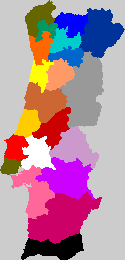- Traditional Arts
- Festivals and Shows

Land
of fairs and popular festivals, feast days and processions, Portugal
keeps hold of its traditions, from the most religious to the most
pagan, all enriched with music, colour and joy.
In
Lisbon, the month of June is reserved for Santo António, the patron
saint of lovers and jokers, the source of prayer for the single and the
reason for the most enjoyable parties in the city which celebrates its
birth on the 13th. ´Saint Anthony was an exemplary Franciscan, and
considered the protector of sailors, milkmaids, the poor, young men
looking for partners and healer of infertilities.
The fame of
Saint Anthony grew and intensified after the 1755 Earthquake, with the
coming together of Christian and pagan practices. On the night between
the 12th and the 13th, the old quarters turn into one big Country fair
and in particular the historic quarter of Alfama - which on this night
becomes the very heart of the city - and everyone in Lisbon goes to the
street, to eat the characteristic grilled sardines, have a glass of
wine and try out their folk dancing skills. It is the largest and
liveliest feast day in the city, which also includes the procession of
the marchas populares with representatives from each district of Lisbon.
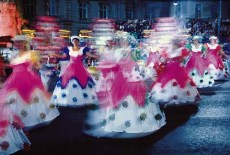
In
Oporto, it is the feast of S. João, held on the night of the 23rd to
the 24th of June. You cannot stay at home on this day and the citizens
of Porto flood the historic districts armed with their leeks and toy
hammers aiming to hit each other on the head. Then there is the feast
day itself with folk dancing on every street corner, typical snacks and
fireworks to mark the feast days of São João, which are of pagan
origin, linked to and celebrating the summer solstice.
If
you are in the Centre of Portugal in July or August try not to miss the
Festas da Ria, in Aveiro, which bring life and liveliness to the city
and are famous due to the river regatta involving moliceiros, the
characteristic coloured boats of the region which at other times take
in the river's produce, a traditional economic activity of the area.
.

Coimbra
is nearby, where you can attend the Queima das Fitas (the burning of
the ribbons), an academic tradition with secular origins, which is held
during the month of May. This tradition of burning the ribbons goes
back to the 1850s. There are news reports of the period when «groups of
students, having learnt that they had passed their 4th year exams,
joined together in their Faculty groups at the Porta Férrea and marched
in procession until the Largo da Feira and there their ribbons received
their dues: they were burnt in a small hole in the ground where a small
fire was burning.» The streets are filled with parades, folk dancing
and those wishing to serenade one another in one of the oldest
university cities in Europe.
A few more kilometres to the
North and we are in Santa Maria da Feira, a city which every August
turns into a medieval village where knights in heavy armour wield great
swords in jousting tournaments. For ten days, the historic city centre
becomes one large fair from out of the Middle Ages with merchants,
artisans, blacksmiths, bakers, mule-drivers and liquor salesmen all
joining together. Inside the castle, you can get a feel for what daily
life must have been like and outside it you can participate in the
famous banquets and savour the delights of another age. In the streets
acrobats, musicians, jugglers and fire eaters show off their arts and
take the visitors on a journey through time.
Also
unmissable is the Festa dos Tabuleiros in Tomar, one of the oldest
religious and cultural events in Portugal. As it is only held once
every four years, mark June 2007 down now to travel to this city of the
Templars to witness this unique event. The festival has its origins in
the worship of the Holy Spirit, which was established by Queen Santa
Isabel. The trays (tabuleiros) which the women carry on their head were
originally offered to the Holy Spirit. The blessing of the trays, the
decorated streets, the quilts placed in the windows, and the flowers
thrown over the procession onto the hundreds of young girls who carry
the trays on their head, makes for an unforgettable spectacle.

Also
unique is the National Horse Fair (previously known as the Feira de S.
Martinho) in Golegã in November, and perhaps one of the most
traditional festivals in the country, which goes back to the 18th
Century. Thousands of people watch the various displays by the
magnificent Lusitanian pure-blood horses And, as the saying goes «Pelo
São Martinho prova o teu vinho» («Saint Martin's place is fine to have
a taste of that wine»), there is always new wine or água-pé in small
barrels available for the visitors, along with the tasty roasted
chestnuts, eaten hot or cold?
If you go down to the Alentejo, do
not forget to visit Campo Maior during the Festival of Flowers and see
how a village can be decorated so colourfully. The roads are
bewitchingly full of paper flowers in happy and colourful designs. This
is normally held in the first week of September, subject to the wishes
of the people.
But traditional Portuguese festivals are also
strongly linked to the religious calendar and there is no city, town or
the smallest village which does not form a procession to go out and
celebrate its saint.
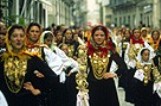
One
of the most important is the Festas da Senhora da Agonia, in Viana do
Castelo where for three days the streets fill with thousands of people
to witness the veneration of the city of the Virgem da Agonia, whom the
fishermen pray to for mild seas.
Or Semana Santa, Holy Week, in
Braga, the former Catholic capital of the Iberian Peninsula, when the
city is decked out in decorations with themes referring to the period
and the «Passos», street side altars, are filled with flowers and
lights, to enhance the sumptuousness of the churches.
Or the
Festas de Nossa Senhora dos Remédios, in Lamego, where every year in
September you can see the Procession of Triumph, the most symbolic of
all the events, where a Senhora dos Remédios is carried on a yoke of
oxen, to make Lamego the only place of Catholic worship where the image
of the Virgin is transported by animals.

Fátima
is also a very unique place, where the apparitions of Our Lady turned
the place into one of the major centres of worship to the cult of Mary
in the world. The largest manifestations of devotion take place on the
13 May, with the Procession of Candles on the night of the 12th and the
Farewell Procession on the day of the 13th, which brings the
celebrations to a close. Every 13th day of the month until October,
Fátima is visited by thousands of believers from all the world.
The archipelagos of Madeira and the Azores are also home to lively popular festivals which are filled with tradition.
In
Funchal, the streets are full of life during Carnival and the Festa da
Flor, held in homage to the flowers of Madeira. During the Festa da
Flor the main streets of Funchal are invaded by a parade of creative
floats which bear witness to the variety of floral species, which leave
subtle wafts of perfume in the air. But the high point is actually the
end of year party in Funchal, which is considered one of the most
famous in the world, due to the spectacular firework display which
marks the passage of each year.
The Azores consists of volcanic
islands in constant activity and frequent tremors, so devotion is the
only refuge of the people, expressed through the cult of the Divino
Espírito Santo and Senhor Santo Cristo dos Milagres which brings
thousands of visitors to the Azores at Easter time.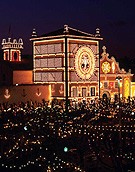
In
S: Miguel a large party is held to honour the feasts of Senhor Santo
Cristo, in which the image of the Convento da Esperança is carried in
procession through the streets on the fifth Sunday after Easter in
Ponta Delgada; a festival spirit and lights play their part to create a
lively atmosphere. And finally on Terceira Island, the feast days of S.
Joaninas take place in June, the major non-religious festival in the
Azores and a veritable calling card for many tourists who make for
Terceira to experience and share the local customs and traditions.
To know more about portuguese touristic regions:
Traditional Arts 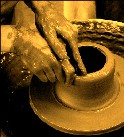
For
centuries Portuguese craftsmen and craftswomen have moulded, spun,
woven, painted and embroidered unique special treasures which have
reflected the soul of their land like nothing else. These traditional
arts have been renewed at the hands of contemporary designers and
artists to bring a new meaning to the term tradition. Skilled and
patient hands continue to give shape to filigree, cross woollen
threads, shape the clay and work the glass. This is the pride and
traditional knowledge of craftspeople in harmony with the Portuguese
creative spirit.
The quality of our handicraft products has
already gone beyond our borders. Did you know that the White House in
Washington has Portuguese porcelain? And that Portuguese crystal and
glass is one of the most admired worldwide? And that Arraiolos carpets
cover the floors of great European palaces? Or that embroidery from
Madeira forms part of the trousseau of princes and princesses? These
are just small examples of the best that is made in Portugal.
- A Country of Tiles
- Tapestries and Embroidery
- Glass and Crystal
- Ceramics and Porcelain
- Filigree
A Country of Tiles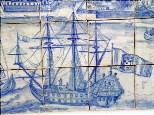
In
Portugal, the tile has always been used in an original way. An
inheritance from the Romans and Arabs, who occupied the Iberian
Peninsula for centuries, the tile has become, as in no other European
country, an artistic expression and a privileged medium for interior,
façade or garden decoration.
Walking on foot through
Portuguese cities is the best way to get to know tiles from any style
or period. To start off, it is best to choose Lisbon and visit the
National Tile Museum, where you can learn everything about its
historical, technical and artistic evolution, from the 15th Century
until the present day, and learn how the tile reflects Portuguese
contact with other cultures.
Then just walk through the city and
admire the colours and patterns which cover or decorate the inside and
outside of so many house, palaces and churches. In the streets of
Alfama, notice how the popular devotional saints protect the quarter,
in small panels placed at the entrance of houses, and how La Fontaine's
fables are recorded on the panels of the Monastery of São Vicente de
Fora, in a kind of cartoon strip from the 17th Century.
Throughout
Chiado or the Bairro Alto, the tile façades will mark the rhythm of
your step. And do not forget to visit the Metro stations, where you
will be surprised by a gallery of subterranean art, with masterpieces
of contemporary tiling, signed by artists of international renown. Your
walk could extend to Sintra so you could visit the Town Palace and get
to know some of the most beautiful and ancient tiles in existence in
Portugal.
But if you want to go further you will have to go by
train from Lisbon to Porto on the northern line where you will find
tiles at some of the stations along the way, and finish up in the
splendour of the tiles in the São Bento railway station in Porto.
While
travelling through the country, you will discover an actual living
museum of tiling but it is in the National Tile Museum, in Lisbon where
you can get to know, in one place, all the history and technical and
artistic evolution from the earliest days up to their manufacture
nowadays.
To know more:
The Tile Museum
Tapestries and Embroidery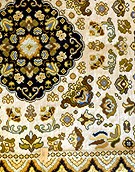
Arraiolos
Carpets and Tapestries from Portalegre are the jewels in the crown of
our textile tradition. In Arraiolos, in the heart of the Alentejo, this
art goes back to the 16th Century. The carpets, internationally famous,
are embroidered in pure wool. The first designs were influenced by
figures from ancient Persian carpets, but nowadays there are an
infinite number of motifs which skilled craftspeople continue to
embroider, whether making copies or one-off pieces.
Also in
the south, embroidery work is carried out in Portalegre, a true
expression of the Portuguese creative spirit. By innovating traditional
techniques, the design is constructed point by point, to allow
impressive detail of around 25 thousand stitches per square metre. The
detail allows the faithful reproduction of plastic works of art with
such perfection that we challenge you to discover the differences
between the tapestries and the originals painted by Vieira da Silva,
Júlio Pomar and Paula Rego.
The Carpets from Beiriz also
have great international prestige and occupy a prominent place in the
artistic industry, and have received prizes in the best exhibitions in
Portugal and abroad. These carpets are characterised by their exuberant
decorative variety and represent one of the most characteristic
manifestations of handicrafts in the country.
Small
pieces of needlework are more popular expressions of the art of sewing.
Those from Madeira or Vila do Conde are true treasures. Also unique
worldwide are the coloured handkerchiefs of boyfriends and girlfriends,
which originate from Viana do Castelo.
Bobbin lace is presently
a form of handicraft which has a limited number of artisans who engage
in it. It was, however, a very widespread activity until a few dozen
years ago, and seamstresses were a very characteristic figure (women
who dedicated themselves to trades such as dressmaking and Bobbin
lace), with their own style of dressing. Documented for centuries, this
activity greatly increased in the 19th Century. However, with the
advent of industrialisation, bobbin lace underwent a retreat. This area
is currently safeguarded and promoted in Peniche, Vila do Conde and in
Póvoa do Varzim, regions where the practice of this handicraft has
existed since ancient times.
From sand and fire comes forth glass. From glass
comes pieces of art. In Portugal, the capital of glass and crystal is
Marinha Grande, a region with a centuries old tradition of glazing.
Glass and crystal are born in similar ways, but it is the great purity
of the raw material which gives crystal weight, brilliance and beauty.
Portuguese glass and crystal pieces, whether traditional or more modern
in design, are today one of the most important Portuguese exports. The
glass route, which includes a visit to five factories in the area, is
an excellent way to get to know everything about Portuguese glass.
To know more:
Glass Route

Portuguese
ceramics have been an expression of the artistic side of the people
since the shaping of clay in Prehistory. However, it was during the
Discoveries, through contact with the Orient, which rekindled the flame
and the Portuguese became specialists in the art of ceramics.
The
Vista Alegre factory, which has been operating for centuries in Ílhavo,
is an example of the best of Made in Portugal. Its pieces are well
known all over the world and the factory also houses a museum and a
centre manufacturing original pieces. Chosen as presents for Kings and
Heads of State, the Vista Alegre pieces are spread throughout the
world, and are to be found at dinner in the White House, in Washington,
or in the house of the Emperor of Japan.
But it is not only
porcelain which visitors to Portugal find enchanting. Earthenware, with
its broad traditions in the country, also occupies a special place.
Clay, whether red or black, has been shaped since time immemorial by
talented artisans who have made unique and original pieces. It is not
difficult to find different ways of working clay since every region of
the country has these. Look closely at the 17th Century reproductions
in Viana do Castelo and Coimbra and, if you prefer more popular types,
enjoy the pottery from Estremoz, which is very colourful and amusingly
recounts Portuguese customs.
Do not forget to also take a
look at the crockery from Caldas da Rainha, the birthplace of Rafael
Bordalo Pinheiro, the unique Portuguese master of the art of Ceramics
and the creator of the famous «Zé-povinho» popular figure. Some of his
ceramics continue to be reproduced nowadays and admired by Portuguese
families.
To know more:
Bordalo Pinheiro Factory
Vista Alegre
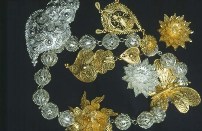
Filigree
is a form of working in gold or silver, using threads the size of a
hair on more delicate pieces, and is a unique and fascinating art.
Authentic illuminations, made of wavy lines and spirals, the
traditional filigree forms continue to be reproduced century after
century, never ceasing to keep their shine and attraction of other
times. In ringed earrings, bracelets and necklaces, personal use is the
most frequent, as can be seen in the Minho, where adornments are the
most important part of the traditional costume of the region.
In
the heart of the 21st Century, new designers still yield to the noble
metal to eternally endow it with new forms. Yield as well and take a
piece with you. The most important workshops are to be found in the
north of the country and the most well known are those of Póvoa do
Lanhoso, Gondomar and Travassos. You can also see more details of this
in the Museum of Gold.
Festivals and Shows
Throughout
the year, Portugal is the stage for the most varied cultural and
sporting events. From music festivals to gastronomic eat-ins, from
shows to exhibitions, from concerts to tennis tournaments or sailing
regattas, the country welcomes everyone with applause literally at
hand, to make these events unforgettable parties.
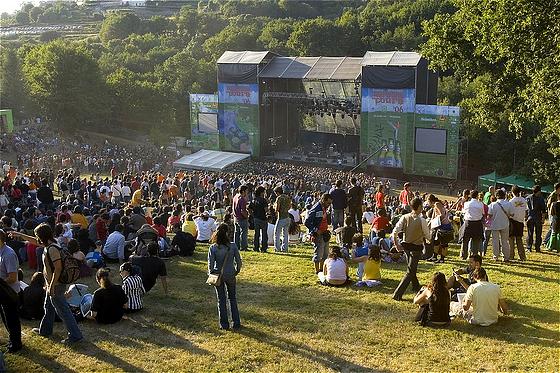



| Gastronomy |
